Green Molecules and Green Chemistry Labs, Part II
Summer snuck up behind me. Before I knew it, high school graduation was here, school was out, and with it, most of the students and teachers who normally populate the Bard Queens hallways I’ve roamed and reacquainted myself with.
One of the first things I was told to expect about the PSF project was to be ready for surprises, and to be ready to take things in stride. Even so, when the end of June approached, I panicked. I knew I couldn’t work in the lab without a supervisor, and knew that Julia would be leaving for China come the last week of school. I hadn’t begun working in the lab until the start of June, since working here required permission from the NYC DOE (bureaucracy has a funny way of stifling creativity). School duties (proctoring, chaperoning, etc.) kept Julia and Cindy busy for a few days, and migraine attacks kept me from the lab once they were back and ready to go. After working in the lab for two weeks, and a cumulative one-week absence, I found myself with a notebook full of ideas but no time left to act them out. I performed what I could and got ready to say goodbye, disappointed that June had come and gone with the wind.
Right before she left, Julia mentioned that Cindy, the lab teaching assistant, was willing to work with me over the summer. Still, she admitted that this rested on its acceptance by the powers that be. I gave her a gift, hugged her, said goodbye, and thanked her for all she had done for me. I waited. Then, ecstasy! Cindy said she would be in the lab, and that I was welcome to pass by anytime.
With no access to an NMR, GC-MS, or other, more advanced instrumentation, synthesizing Fe-TAMLs was out of reach. Worse still, with Julia gone, the time to learn about her work with them had passed. Despite this, her advice and knowledge have led me down another path, one that Cindy and I are ready to investigate.
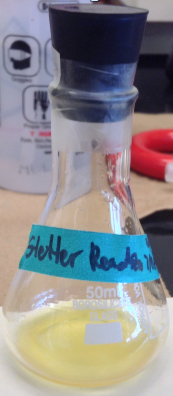
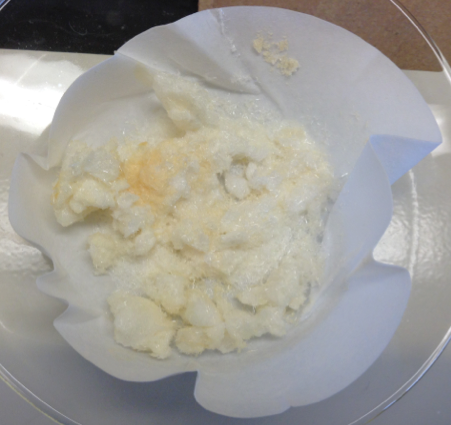
The two products above were produced using thiamine, or Vitamin B1, as a catalyst. Its derivatives catalyze biochemical reactions necessary for life; it has found use in organic chemistry, replacing the use of cyanide salts, which are notoriously toxic. Its use leads to the production of relatively benign, dilute, aqueous ethanol waste. The yellow liquid on the left was produced using the Stetter reaction, a synthetic method known for its usefulness in synthesizing 1,4-dicarbonyls, compounds that are themselves useful building blocks but difficult to synthesize. The pale-yellow crystals on the right were prepared using the Benzoin condensation. The product is also a useful building block, being used in the synthesis of phenytoin, an anticonvulsant deemed an essential medication by WHO.
Biocatalysis is normally favored due to its fidelity, since the enzymes used are selective for certain substrates and tend to produce chiral compounds (see: Carbonyl Reductions using Baker's Yeast). 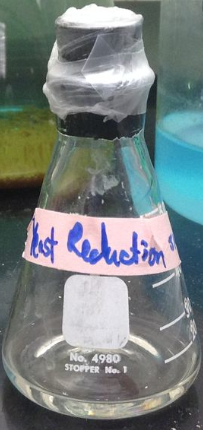 However, enzymes are fragile, requiring near-physiological conditions to maintain their usefulness. As such, creating analogues of biocatalysts that maintain their chemical activity while increasing their sturdiness remains a worthwhile pursuit. Fe-TAMLs, for example, were themselves rationally-designed based on the structure of a biological oxidation catalyst, horseradish peroxidase. To a biochemistry major who is heavily interested in the greener aspects of chemistry as they relate to pharmaceuticals, this connection is deeply thought provoking and enticing. Not only does biocatalysis represent a green chemistry technique with real-world applicability in the synthesis of pharmaceuticals, it is a field full of promise, allowing for the rational-design of analogues and the experimentation entailed thereof that any and every chemist desires.
However, enzymes are fragile, requiring near-physiological conditions to maintain their usefulness. As such, creating analogues of biocatalysts that maintain their chemical activity while increasing their sturdiness remains a worthwhile pursuit. Fe-TAMLs, for example, were themselves rationally-designed based on the structure of a biological oxidation catalyst, horseradish peroxidase. To a biochemistry major who is heavily interested in the greener aspects of chemistry as they relate to pharmaceuticals, this connection is deeply thought provoking and enticing. Not only does biocatalysis represent a green chemistry technique with real-world applicability in the synthesis of pharmaceuticals, it is a field full of promise, allowing for the rational-design of analogues and the experimentation entailed thereof that any and every chemist desires.
With Fe-TAMLs as the root of my inspiration, I plan on exploring the use of biocatalysts in green organic synthesis, and the green organic synthesis of biologically relevant compounds. The benzoin we produced using Vitamin B1 will be used to produce phenytoin in a green manner, by using bleach to synthesize the intermediate compound, benzil. Immobilized lipase will be used in the selective-esterification of 4-hydroxybenzyl alcohol to produce 4-hydroxybenzylacetate, a tyrosinase-inhibitor that reduces melanin production and is used for cosmetic purposes. The immobilized enzyme will then be recycled for later use, providing a greener biocatalytic approach to traditional esterification reactions.
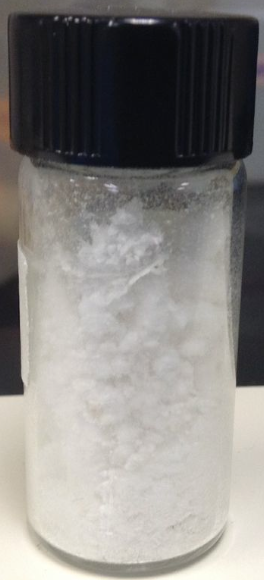 Already, we have synthesized biologically-active compounds using a greener-version of the Biginelli reaction (shown left, white crystalline solid), a solvent-free take requiring only 15 minutes to run to completion.
Already, we have synthesized biologically-active compounds using a greener-version of the Biginelli reaction (shown left, white crystalline solid), a solvent-free take requiring only 15 minutes to run to completion.
Additionally, we have synthesized dulcin (shown right, brown solid),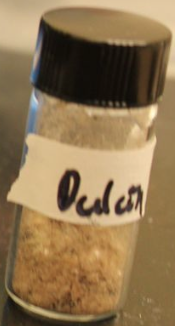 an artificial sweetener, from the OTC analgesic Tylenol, using a one-pot method that minimizes solvent-use and takes advantage of already available starting materials.
an artificial sweetener, from the OTC analgesic Tylenol, using a one-pot method that minimizes solvent-use and takes advantage of already available starting materials.
Currently, Cindy and I are scheming of other biologically-relevant and interesting compounds to synthesize in a green fashion. While the rest of the project will continue to focus on the junction between biochemistry and green chemistry, staple undergraduate organic chemistry experiments, such as the Aldol condensation and Grignard reaction, will be revisited and revised to be more green. Other standard reactions, such as the Baeyer-Villiger oxidation and reductive amination, though seldom performed at the undergraduate level, will be modified to increase their practicality and minimize their negative environmental-impact.
And although one door has closed, its influence remains, and thanks to it, many more remain to be opened.
Stay Tuned!
Tags: psf, presidents summer fellowship, chemistry, biochemistry, green chemistry
